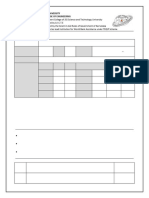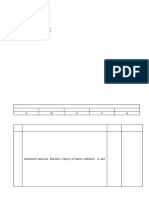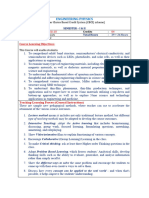Physics Syllabus
Uploaded by
syedPhysics Syllabus
Uploaded by
syedB.Tech.
Computer Science and Engineering Regulations 2021
SEMESTER I
PHD 1182 ENGINEERING PHYSICS L T P C
SDG: 4 3 0 2 4
COURSE OBJECTIVES:
COB1: To equip the students on the knowledge of electromagnetic waves.
COB2: To make the students in understanding the importance of mechanics.
COB3: To introduce the basics of oscillations, optics and lasers.
COB4: To acquire basic knowledge about the principle and theory of solids.
COB5: To understand the importance of physics behind semiconductor
devices.
MODULE I ELECTROMAGNETIC WAVES 9
Gauss’s law – Faraday’s law - Ampere’s law–Properties of electromagnetic
waves: speed, amplitude, phase, orientation and waves in matter - polarization -
producing electromagnetic waves - Energy and momentum in EM waves:
Intensity, waves from localized sources, momentum and radiation pressure -
Reflection and transmission of electromagnetic waves from a non-conducting
medium.
MODULE II QUANTUM MECHANICS 9
Black body radiation – Planck’s theory of radiation – Deduction of Wien’s
displacement law and Rayleigh-Jean’s law– Matter waves–Physical significance
of wave function – Schrodinger wave equation – Time independent and time-
dependent wave equation – Applications: Particle in one-dimensional box –
Introduction to quantum computing.
MODULE III OSCILLATIONS, OPTICS AND LASERS 9
Simple harmonic motion - resonance - waves on a string - standing waves -
traveling waves - Energy transfer of a wave - Anti-reflection coating - Air Wedge
– Michelson’s Interferometer – Determination of wavelength of light and
thickness of thin transparent sheet-Characteristics of Laser – Spontaneous and
Stimulated Emissions – Einstein’s Coefficients - Population inversion –
Pumping Mechanism – Laser Action – Types of Laser: Nd:YAG laser He-Ne
laser and semiconductor laser - Applications : Laser Materials Processing -
Holography.
B.S. Abdur Rahman Crescent Institute of Science and Technology 43
B.Tech. Computer Science and Engineering Regulations 2021
MODULE IV INTRODUCTION TO SOLIDS 9
Free electron theory of metals- Expression for electrical conductivity of metal-
Fermi level-Fermi distribution function-Effect of Fermi function with temperature-
Density of energy states-carrier concentration in metals-Effect of temperature
on Fermi energy- Energy distribution of electrons- Work function of a metal-
Electron in a periodic potential (Kronig and Penny model)-Brillouin Zones-
Fermi surface-Effective mass of electron and hole-Energy bands in solids.
MODULE V PHYSICS OF SEMICONDUCTORS 9
Elemental and compound semiconductors –Direct and Indirect band gap
semiconductors- Drift and diffusion current – Intrinsic semiconductors: Intrinsic
carrier concentration (derivation) – Fermi energy – Variation of Fermi energy
level with temperature – Mobility and electrical conductivity – Band gap
determination – Extrinsic semiconductors – Carrier concentration in n-type and
p-type semiconductor (derivation) – Variation of Fermi level with temperature
and impurity concentration – Variation of Electrical conductivity with
temperature – Hall effect – Experiment and applications of Hall effect.
PRACTICALS
List of Experiments
1. Determination of thickness of a thin wire / sheet using Air Wedge method.
2. Determination of wavelength of laser light using semiconductor laser
diffraction.
3. Determination of angle of divergence of a laser beam using
semiconductor diode laser and He-Ne laser.
4. Resistivity measurement of a semiconductor using four point probe
method.
5. Determination of band gap of a semiconductor diode.
6. Determination of Hall coefficient of a given semiconductor material.
7. Determination of frequency of a tuning fork using Melde’s string
arrangement in transverse and longitudinal modes.
8. Determination of particle size of lycopodium powder using semiconductor
laser.
L – 45; P – 30 ; Total Hours – 75
B.S. Abdur Rahman Crescent Institute of Science and Technology 44
B.Tech. Computer Science and Engineering Regulations 2021
TEXT BOOKS:
1. P K. Palanisamy, Engineering Physics Vol I and II Scitech Publications
(India) Pvt Ltd, 2018.
2. Gaur R.K. and Gupta S.L., Engineering Physics, 8th edition, Dhanpat Rai
Publications (P) Ltd., New Delhi, 2013.
REFERENCES:
1.D.J.Griffiths. Introduction to Electrodynamics. Pearson Education, 2015.
2.Serway R.A. and Jewett, J.W., Physics for Scientists and Engineers with
Modern Physics, Brooks/cole Publishing Co., 2010.
3.Tipler P.A. and Mosca, G.P., Physics for Scientists and Engineers with
Modern Physics, W.H. Freeman, 2007.
4.Markert J.T., Ohanian. H. and Ohanian, M., Physics for Engineers and
Scientists, W.W. Norton & Co., 2007.
5.Palanisamy P.K., “Semiconductor physics and optoelectronics” Scitech
Publications, 2003.
6.Linear Integrated Circuits by D. Roy Choudhury and Shail Jain - New Age
International (P) Ltd.(2003).
7.Integrated Electronics by J.Millman and C.Halkias, Tata McGraw Hill, New
Delhi (2001).
COURSE OUTCOMES:
CO1: Express the knowledge of electromagnetic waves.
CO2: Comprehend the importance &principles of quantum mechanics andapply
it to understand ideas of quantum computing.
CO3: Grasp ideas related to oscillations, interference phenomenon, apply it to
understandoptical based devices and classify the different laser systems used
forvarious applications.
CO4: Conceptualize the electron theory of metals and band structure of solids.
CO5: Understand the principles of physics behind semiconductors, Hall
effectand apply the same to identify type of any semiconductor sample,
evaluateno. of charge carriers.
Board of Studies (BoS) : Academic Council:
BOS of Physics was held on 21.06.21 17th AC held on 15.07.2021
B.S. Abdur Rahman Crescent Institute of Science and Technology 45
B.Tech. Computer Science and Engineering Regulations 2021
PO PO PO PO PO PO PO PO PO PO PO PSO PSO PSO
PO8
1 2 3 4 5 6 7 9 10 11 12 1 2 3
CO1 H M L L M M M L L L M M
CO2 H M M L L M L L L L L M
CO3 H M M L L L L L L L L M
CO4 H M M L M M M L L L M M
CO5 H M M L M M M L L L M M
Note: L- Low Correlation M -Medium CorrelationH -High Correlation
SDG 4:Ensuring inclusive and equitable quality education for all persons and
promote lifelong learning opportunities.
Statement: The modules and topics mentioned in this course are designed to
ensure all inclusive and thorough education with equity to all persons and
promote learning opportunities at all times.
B.S. Abdur Rahman Crescent Institute of Science and Technology 46
You might also like
- 01GS1101 - Engineerig Physics - Soft BranchNo ratings yet01GS1101 - Engineerig Physics - Soft Branch3 pages
- Engineering Physics 24PH110 - 24PH210 - First Year (1st and 2nd Sem) BENo ratings yetEngineering Physics 24PH110 - 24PH210 - First Year (1st and 2nd Sem) BE5 pages
- THEORY-PHYS1036-SEM-I II-All-SoCS-BRANCHES at 4 CREDITNo ratings yetTHEORY-PHYS1036-SEM-I II-All-SoCS-BRANCHES at 4 CREDIT3 pages
- PHY1008_MODERN-PHYSICS_ETH_2.0_4_PHY1008 -V 2.0 -Modern PhysicsNo ratings yetPHY1008_MODERN-PHYSICS_ETH_2.0_4_PHY1008 -V 2.0 -Modern Physics3 pages
- B Tech First Year Syllabus Common For AllNo ratings yetB Tech First Year Syllabus Common For All47 pages
- REVISED SYLLABUS-ASH DEPT B.TECH ECE AI CSE AI AI ML (1)No ratings yetREVISED SYLLABUS-ASH DEPT B.TECH ECE AI CSE AI AI ML (1)18 pages
- Syllabus_Engineering_Physics_BOS-JAN-2022No ratings yetSyllabus_Engineering_Physics_BOS-JAN-20228 pages
- EE1002 Physics Foundation For Electrical and Electronic Engineering - OBTLNo ratings yetEE1002 Physics Foundation For Electrical and Electronic Engineering - OBTL4 pages
- Open Elective Winter Semester, B.Tech. Bio-Physics (Revised)No ratings yetOpen Elective Winter Semester, B.Tech. Bio-Physics (Revised)7 pages
- Gujarat Technological University: 1 Year, Subject Code: 3110018No ratings yetGujarat Technological University: 1 Year, Subject Code: 31100184 pages
- Examination Scheme & Syllabus P1 Group 1st SemNo ratings yetExamination Scheme & Syllabus P1 Group 1st Sem17 pages
- Physics (Ee) (Bs Ph 201)Course File (2018-19)No ratings yetPhysics (Ee) (Bs Ph 201)Course File (2018-19)32 pages
- Silver Oak University: College of TechnologyNo ratings yetSilver Oak University: College of Technology4 pages
- (Engg. Physics) 2024-25 syllabus -TUTORIAL SHEETS (1).docxNo ratings yet(Engg. Physics) 2024-25 syllabus -TUTORIAL SHEETS (1).docx22 pages
- Engineering Physics Course Syllabus 2023 1No ratings yetEngineering Physics Course Syllabus 2023 15 pages
- Engg - Physics Forcomputer Science Stream 2023 24No ratings yetEngg - Physics Forcomputer Science Stream 2023 245 pages
- BTech_PHYSICS_CBCS_Syllabus_uploaded_on_July_25_2022__1_ by Dr KBNo ratings yetBTech_PHYSICS_CBCS_Syllabus_uploaded_on_July_25_2022__1_ by Dr KB6 pages
- Syllabus B.Tech. First Yr Biotechnology Effective From 2022 23 RNo ratings yetSyllabus B.Tech. First Yr Biotechnology Effective From 2022 23 R44 pages
- Engineering Physics - Course - Syllabus - 2023-24No ratings yetEngineering Physics - Course - Syllabus - 2023-245 pages
- RC2019 20 FirstYear Engg Scheme SyllabusNo ratings yetRC2019 20 FirstYear Engg Scheme Syllabus28 pages
- Phy1701 Engineering-Physics Eth 1.0 46 Phy1701 PDFNo ratings yetPhy1701 Engineering-Physics Eth 1.0 46 Phy1701 PDF3 pages
- Phy1701 Engineering-Physics Eth 1.0 46 Phy1701 PDFNo ratings yetPhy1701 Engineering-Physics Eth 1.0 46 Phy1701 PDF3 pages
- Chapter 6 Spectrphotometric Assay TechniueNo ratings yetChapter 6 Spectrphotometric Assay Techniue27 pages
- Guideline For Feld Testing of Reciprocating Compressor Performance PDF100% (1)Guideline For Feld Testing of Reciprocating Compressor Performance PDF173 pages
- Synthesis and Study of Polypyrrole Thin Films by Silar MethodNo ratings yetSynthesis and Study of Polypyrrole Thin Films by Silar Method6 pages
- Molar Mass, Moles, Percent Composition ActivityNo ratings yetMolar Mass, Moles, Percent Composition Activity2 pages
- Hydrochloric Acid AND Miscellaneous Inorganic ChemicalsNo ratings yetHydrochloric Acid AND Miscellaneous Inorganic Chemicals9 pages
- Please Remember To Photocopy 4 Pages Onto One Sheet by Going A3 A4 and Using Back To Back On The PhotocopierNo ratings yetPlease Remember To Photocopy 4 Pages Onto One Sheet by Going A3 A4 and Using Back To Back On The Photocopier10 pages
- Ch128P: Principles of Transport Processes Worksheet No. 5: DiffusionNo ratings yetCh128P: Principles of Transport Processes Worksheet No. 5: Diffusion1 page
- 14 1. Basic Physics of Lasers: Radiationless TransitionNo ratings yet14 1. Basic Physics of Lasers: Radiationless Transition3 pages
- Chen Et Al 2024 The Promise and Challenges of Inverted Perovskite Solar CellsNo ratings yetChen Et Al 2024 The Promise and Challenges of Inverted Perovskite Solar Cells78 pages
- SS 2 1ST Term Scheme of Work Week 6-9 ContinuationNo ratings yetSS 2 1ST Term Scheme of Work Week 6-9 Continuation8 pages
- FORM 3 SULPHUR AND ITS COMPOUNDS QUESTIONS Teacher - Co - .KeNo ratings yetFORM 3 SULPHUR AND ITS COMPOUNDS QUESTIONS Teacher - Co - .Ke8 pages
- Engineering Physics 24PH110 - 24PH210 - First Year (1st and 2nd Sem) BEEngineering Physics 24PH110 - 24PH210 - First Year (1st and 2nd Sem) BE
- THEORY-PHYS1036-SEM-I II-All-SoCS-BRANCHES at 4 CREDITTHEORY-PHYS1036-SEM-I II-All-SoCS-BRANCHES at 4 CREDIT
- PHY1008_MODERN-PHYSICS_ETH_2.0_4_PHY1008 -V 2.0 -Modern PhysicsPHY1008_MODERN-PHYSICS_ETH_2.0_4_PHY1008 -V 2.0 -Modern Physics
- REVISED SYLLABUS-ASH DEPT B.TECH ECE AI CSE AI AI ML (1)REVISED SYLLABUS-ASH DEPT B.TECH ECE AI CSE AI AI ML (1)
- EE1002 Physics Foundation For Electrical and Electronic Engineering - OBTLEE1002 Physics Foundation For Electrical and Electronic Engineering - OBTL
- Open Elective Winter Semester, B.Tech. Bio-Physics (Revised)Open Elective Winter Semester, B.Tech. Bio-Physics (Revised)
- Gujarat Technological University: 1 Year, Subject Code: 3110018Gujarat Technological University: 1 Year, Subject Code: 3110018
- (Engg. Physics) 2024-25 syllabus -TUTORIAL SHEETS (1).docx(Engg. Physics) 2024-25 syllabus -TUTORIAL SHEETS (1).docx
- BTech_PHYSICS_CBCS_Syllabus_uploaded_on_July_25_2022__1_ by Dr KBBTech_PHYSICS_CBCS_Syllabus_uploaded_on_July_25_2022__1_ by Dr KB
- Syllabus B.Tech. First Yr Biotechnology Effective From 2022 23 RSyllabus B.Tech. First Yr Biotechnology Effective From 2022 23 R
- Phy1701 Engineering-Physics Eth 1.0 46 Phy1701 PDFPhy1701 Engineering-Physics Eth 1.0 46 Phy1701 PDF
- Phy1701 Engineering-Physics Eth 1.0 46 Phy1701 PDFPhy1701 Engineering-Physics Eth 1.0 46 Phy1701 PDF
- Quantum Mechanics for Applied Physics and EngineeringFrom EverandQuantum Mechanics for Applied Physics and Engineering
- Guideline For Feld Testing of Reciprocating Compressor Performance PDFGuideline For Feld Testing of Reciprocating Compressor Performance PDF
- Synthesis and Study of Polypyrrole Thin Films by Silar MethodSynthesis and Study of Polypyrrole Thin Films by Silar Method
- Hydrochloric Acid AND Miscellaneous Inorganic ChemicalsHydrochloric Acid AND Miscellaneous Inorganic Chemicals
- Please Remember To Photocopy 4 Pages Onto One Sheet by Going A3 A4 and Using Back To Back On The PhotocopierPlease Remember To Photocopy 4 Pages Onto One Sheet by Going A3 A4 and Using Back To Back On The Photocopier
- Ch128P: Principles of Transport Processes Worksheet No. 5: DiffusionCh128P: Principles of Transport Processes Worksheet No. 5: Diffusion
- 14 1. Basic Physics of Lasers: Radiationless Transition14 1. Basic Physics of Lasers: Radiationless Transition
- Chen Et Al 2024 The Promise and Challenges of Inverted Perovskite Solar CellsChen Et Al 2024 The Promise and Challenges of Inverted Perovskite Solar Cells
- SS 2 1ST Term Scheme of Work Week 6-9 ContinuationSS 2 1ST Term Scheme of Work Week 6-9 Continuation
- FORM 3 SULPHUR AND ITS COMPOUNDS QUESTIONS Teacher - Co - .KeFORM 3 SULPHUR AND ITS COMPOUNDS QUESTIONS Teacher - Co - .Ke

























































































